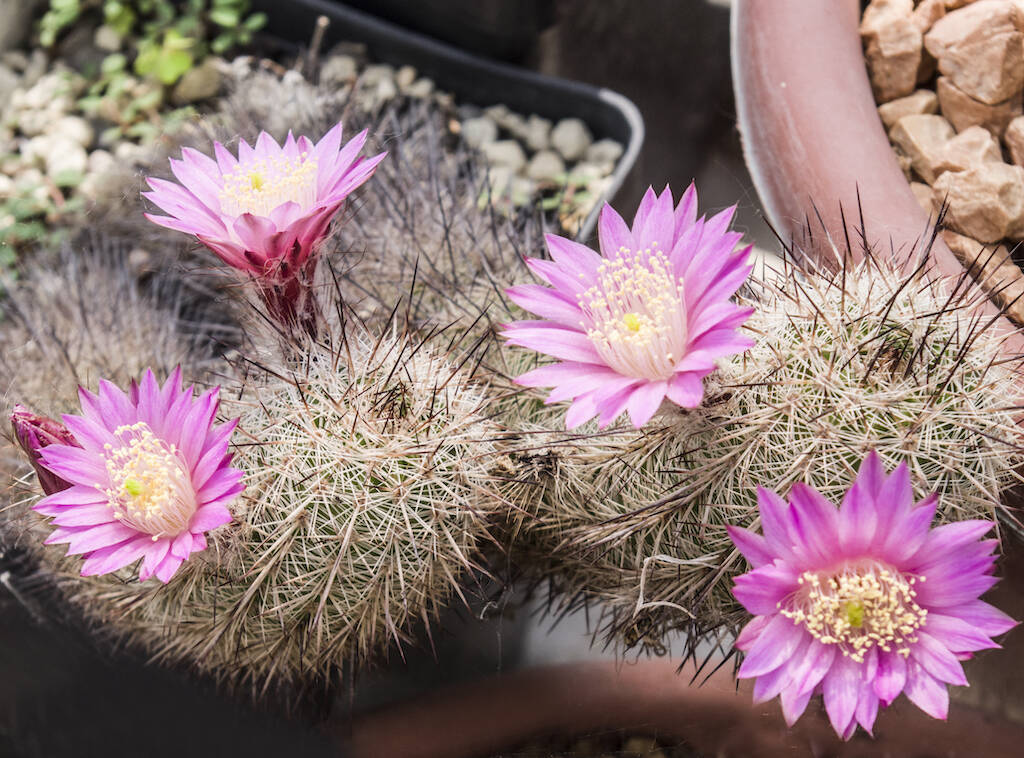Many succulents, whether cacti or other succulent families, tolerate the cold well. Not all cacti and not all succulents, of course, but many species can face the winter without problems even outdoors not only in the regions of Southern Italy, but also in many European states or in Asia and in northern America. The story of the Echinocereus laui in the photo above contains a very important lesson from this point of view. With the exception of epiphytic cacti (Schlumbergera, Epiphyllum, Rhipsalis, etc.), for species such as Melocactus and Discocactus and for succulent plants native to Madagascar or some African regions (Adenium obesum, Uncarina, Aloe, many Euphorbia and almost all Asclepiadaceae), many succulents can spend the winter months at temperatures close to zero Celsius degrees, as long as the soil remains dry at least from October to the end of March. However, there are some cacti and some succulents capable of surprising us and surviving the rigors of winter without problems, in some cases even in damp soil (therefore partly exposed to the elements).
Among these, some species of Echinocereus, as the plant you see in the photo, which I had given up for dead, and whitch instead was reborn after two winters spent entirely outdoors, exposed to the cold and humidity whitch characterizes northern Italy. In this article here is the history of this plant and a brief overview of the succulent plants that we can keep outdoors all year round. (…)
Premise
The precautions we take to protect our succulents during the winter months, particularly in the Northern regions, are important. Yes, because if it is true that most cacti and many succulents (to understand the difference between cacti and succulents you can read this article) have good resistance to the cold, it is equally true that too much watering or a night frost is enough to seriously damage these plants or, potentially, trigger rot, particularly if the cold is accompanied by prolonged environmental humidity conditions. Moving the plants to a place sheltered from the rain, covering them with various layers of non-woven fabric, sheltering them in not cramped greenhouses and airing them on sunny days is certainly the best solution to minimize losses. In some cases even this is not enough: think of cacti such as Melocactus, Discocactus and all epiphytes, or succulents originating from Madagascar and some African areas, such as many Euphorbias and all Adenium obesum. All these plants require minimum temperatures not lower than 15-16 Celsius degrees and must therefore be brought indoors from at least mid-October, when the night-time minimum temperatures begin to drop significantly.
The Echinocereus returned from the cold
Having made the necessary introduction, here is the story of this Echinocereus of mine who wanted to amaze me, at the same time giving me an important lesson and reiterating the concept – which I have already assimilated thanks to other experiences in the past – that with succulent plants it is important not to give anything for granted. The plant in question is an Echinocereus laui. I grow a few specimens of the Echinocereus genus and I grow them mainly for the flower, since I don’t find the stems or thorns of these plants particularly attractive (with a few exceptions such as E. lindsayi). The plant you see in the photos has been with me for several years. Doing some quick calculations, just under twenty years to be more precise and the story of his “apparent death” and rebirth (in the cold) dates back at least four years. Initially this plant, which I took while still very small, in a 6 or 7 centimeter pot, grew regularly, soon starting to take on its columnar shape (although its size was limited to about fifteen centimeters) and to flower regularly.
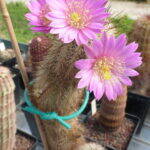
At a certain point, years ago, the main stem sent out a branch and the plant, little by little, took on a “double” appearance: over time the stem and the branch in short reached the same height. Well before the branch reached the main stem, however, the latter began to bend significantly, to the point that I decided to tie it to a plant support. In those years the plant grew regularly and flowered, as can be seen from the photo on the side. After further years, when the two stems were now even, the Echinocerus began to slow down its growth, until it stopped completely. The apex did not develop and did not produce new spines. In the meantime, the stems were bending more and more noticeably despite the support and the lower part of the plant began to take on a grey, not at all encouraging, appearance.
After a couple of seasons, seeing that the Echinocereus showed no signs of recovery and that the entire stem had now taken on an ugly greyish colour, I thought there was nothing left to do. The plant did not grow or flower. It showed no obvious signs of rot but the color of the stem seemed like a complete condemnation, to the point that I didn’t even bother to dig up the plant and check the roots. Considering it to be in fact already dead, I limited myself to removing it from the greenhouse and taking it outside, placing it along a low wall where I usually leave the plants affected by some fungus or otherwise dead. The wall is located along a field and offers no shelter from the rain and, obviously, from the cold. I use it mostly to let the plants go in peace when I think there’s nothing left to do…
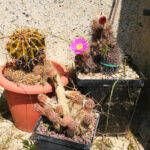
The Echinocerus spent the final part of the summer in that position, the entire following winter and, since I completely forgot about it, the entire year after that, including the winter. Only after a year and a half, therefore, did the plant manage to attract my attention. How did it do? Simply flowering, so that while hanging out near the greenhouse I spotted a couple of spots of color in the distance (Echinocereus laui produces beautiful magenta flowers, not as large as those of other Echinocereus but still very showy). Not without surprise, I approached the wall after almost two years and discovered that the Echinocereus had not only survived two winters in the cold, in full humidity and receiving the rain that had fallen in all that time, but had started again. The recovery was evident: the apical part of the two stems was green, the plant had produced new thorns perfectly identical to the old ones, and had flowered. As proof of all this, here in this article are some of the photos I took on that occasion.
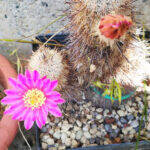
Here’s a good lesson for me: the plant I had given up on had come back to life, in my face, and had attracted my attention by starting to flower again. All this without any treatment from me, in fact, resisting the cold and humidity of two winters and returning to grow as if nothing had happened. Obviously, as soon as I discovered that the Echinocereus was in full vegetation and, even with the old part of the stem still grey, I brought it back to the greenhouse, where it is still found today and where every year the two stems, increasingly longer and increasingly prostrate (I gave up the support, letting the plant take on the shape it wanted or needed to take on) they regularly give me splendid blooms in late spring. Once again Nature has shown me that, no matter what we do, in the end it is always and only she who decides.
Succulents that tolerate cold
Despite the “rebirth” of my Echinocereus, it must be said that this genus of cactus is among the most inclined to tolerate low temperatures. Of course, as a precaution I don’t recommend keeping your Echinocereus outdoors all year round, also because some species resist better than others and not all would survive, but the genus is robust, there’s no doubt about that.
As regards, more generally, succulent plants that tolerate the cold well and that we can leave outdoors all year round, albeit with some precautions, here is a small overview based on my experience over many years of cultivation.
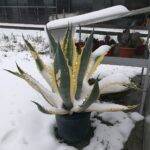
As obvious as we want, but among the first succulents that have a good relationship with the cold we cannot fail to mention the Agaves. In many areas of Italy (even in the North, particularly in the areas close to lakes) and in southern France (French Riviera) these succulents can also be grown in the open ground. In pots they can remain outdoors all year round, although the advice is to keep them under sheds or porches to prevent the soil from remaining constantly damp. Among the Agaves, the exception is the macroacantha species, which cannot resist intense cold and excessive humidity. This species must therefore be sheltered and kept at temperatures no lower than 3 or 4 Celsius degrees. Also be careful with Aloes, which many mistakenly associate with Agaves. Aloes are plants of African origin and require significantly higher minimum temperatures than Agaves (although 6 or 7 Celsius degrees are sufficient) and should not be watered in winter.
Still remaining in the field of non-cacaceae succulents, the Sempervivum and Sedum (genera belonging to the Crassulaceae family) should be mentioned without hesitation. For these plants, which also grow in the mountains, winter is a… walk in the park and they thrive better in the cold than closed in a greenhouse or sheltered by layers of non-woven fabric. Sedum and Sempervivum can therefore be left outdoors all year round without any shelter from the rain: they grow better in the cold than in the oppressive heat of summer!
Cacti that resist outdoors
Most cacti can handle the cold very well, even intense temperatures, i.e. with night-time lows around zero Celsius degrees (even a few degrees lower), as long as they are in a dry substrate from the end of September. Some genera are even more robust and can be kept outdoors all year round, in some cases even in damp soil (but avoiding the stagnation that can be created with excessively peaty substrates or, worse, leaving the plants resting on saucers).
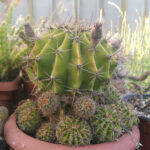
Among the most resistant cactaceae are undoubtedly almost all Echinopsis, which are often left on balconies and terraces with the only precaution of sheltering them from the rain (although these plants are often able to survive even in damp soil). Almost all Opuntias are very robust and, like the Agaves, in some areas (Southern Italy, the Ligurian Riviera, the French Riviera) grow in the open ground without any problem. Tephrocactus, Chilean plants that have some affinities with Opuntia, also tolerate the cold well and can spend the winter outdoors, as long as they are sheltered from the rain. However, a spray from time to time during the winter months is useful for these cacti, which if kept dry for months easily lose their “cladodes” (the new parts of the stem). Within the Tephrocactus genus, however, it is useful to keep the geometricus species sheltered, which is very “in fashion” in recent years: the cold and humidity easily cause stains on the stem of this cactus.
Other genera of cacti accustomed to spending long periods in intense cold are the Pediocactus and the Escobaria (almost all species). These are not very widespread genera but are ideal for those who want to grow cacti without having to move them in the winter months. Pediocactus and some species of Escobaria (for example E. vivipara) can tolerate temperatures several degrees below zero even in damp soil. For years I have kept some specimens of Pediocactus (simpsonii and knowltonii) and some Escobaria vivipara outside the greenhouse all year round, letting them get the rain even in winter: they have always resisted and flowered regularly.
SUBSCRIBE TO THE SITE – If you liked this article, subscribe to the site to have unlimited access to all the contents for one year or three months depending on the formula you choose. Here you will find terms and conditions.
SUBSCRIBE TO THE NEWSLETTER – If you want to receive the free newsletter every time new content is published, fill in the fields at this link!
Correlated articles
- Where to keep succulents in winter?
- Succulents and cold: minimum temperatures
- Seasonal care for cacti and succulents
- Be careful of winter blooms
© The texts, videos, photos and graphic elaborations of the site “Il fiore tra le spine” are original material and are covered by copyright. It’s forbidden to reproduce them in any way.


